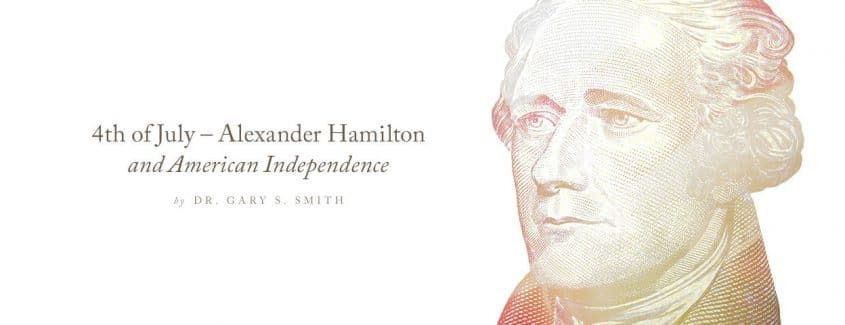
As we celebrate the 4th of July, Lin-Manuel Miranda’s hit musical “Hamilton” is lionizing the life and legacy of Alexander Hamilton. “Hamilton” won 11 Tony Awards, including best musical, a Grammy Award for best musical theater album, the Pulitzer Prize for drama, and the Kennedy Prize for Drama Inspired by American History. “Hamilton” is likely to “become one of the biggest critical and commercial hits in Broadway history” and will go on a national tour in 2017. Miranda’s musical is inspired by his reading of Ron Chernow’s 2004 best-selling book “Alexander Hamilton.”
Chernow declares: “I think he has plucked out the dramatic essence of the character—his vaulting ambition, his obsession with his legacy, his driven nature, his roving eye, his brilliant mind, [and] his faulty judgment.” While many historians praise the historical accuracy of Miranda’s musical, others accuse him of glorifying Hamilton and downplaying the less savory aspects of his life. Disputes about Hamilton’s character and contributions are not new. During his life and since his death in 1804, his personal traits and actions have been fiercely debated. Miranda argues that Thomas Jefferson, James Madison, James Monroe and John Quincy Adams “all hated Hamilton, and did their best” to both “assassinate his character” and to “bury him by omission.’’
Prior to the sensational success of Miranda’s musical, most Americans probably knew little about Hamilton, perhaps only that he penned many of the Federalist Papers, served as the first Secretary of the Treasury (his picture is on the $10 bill), and was killed in a duel by Vice President Aaron Burr.
The first song of Miranda’s musical asks: How did a largely self-taught orphan rise from a deprived childhood in the Caribbean to become a celebrated founder who served as an important aide to George Washington during the Revolutionary War, wrote more than half of the Federalist Papers, played the central role in the creation of the new nation’s financial system, and served as “the bane and bugbear of everyone” from Burr to Jefferson and Madison?
Of all the founders, Hamilton had the most troubled childhood and the most tragic death. His contributions to his fledgling nation, however, are indeed monumental. Hamilton was born in either 1755 or 1757 (the precise date is unknown) to an unmarried mother in the West Indies, but was orphaned as a child. After he came to British North America as a teenager, however, wealthy men, who recognized his ability and drive, paid for his education at King’s College (now Columbia University).
During the Revolutionary War, Hamilton served as a senior aide to Commander-in-Chief George Washington, who often sent him to convey his instructions to other military leaders. His writings and actions helped win ratification for the Constitution, place the young country on a solid economic basis, and establish one of the nation’s original political parties—the Federalists. He also helped found the Bank of New York, the U.S. Mint, the United States Coast Guard, and “The New York Post” newspaper.
Hamilton led the Annapolis Convention, which convinced Congress to call a convention in Philadelphia to create a new constitution. He actively participated in the discussions at this convention, and, more importantly, he helped persuade Americans to ratify the Constitution by penning 51 of the 85 Federalist Papers, which continue to be the “most important reference for Constitutional interpretation.”
Hamilton served as the country’s first secretary of the treasury and was the chief architect of the economic policies of Washington’s administration. He was a strong nationalist who contended that the implied powers of the Constitution gave the federal government the legal authority to direct the nation’s economy. He helped convince Congress to pay off both the federal and state debt incurred in fighting the Revolutionary War in order to restore the nation’s financial standing at home and abroad, thus winning the allegiance of many Americans to the national government. He also helped persuade Congress to establish a national bank and Americans to develop positive relations with Britain.
While admitting that Hamilton’s “legendary ambitions were motivated” in part by self-interest, Chernow contends that his “passionate patriotism” and indomitable will enabled him to effectively lay the foundation for “American prosperity and power.” Chernow also calls Hamilton America’s “most central figure.” While this is debatable, Hamilton clearly played a major role in helping the new United States succeed as it faced continued challenges from Britain, France, and Spain who coveted land west of the original 13 states.
Although Alexander Hamilton was one of the few major founders who was not elected as a governor, senator, or president, he had an extraordinary career. During the last 15 years of his life, Hamilton endured both personal and political scandals, and he was killed in America’s most infamous duel by a bullet fired by arguably his fiercest rival, Aaron Burr. As we sing patriotic songs, watch parades and fireworks, and eat quintessentially American cuisine on July 4th, let us remember the role that Alexander Hamilton played in procuring and ensuring our independence.



